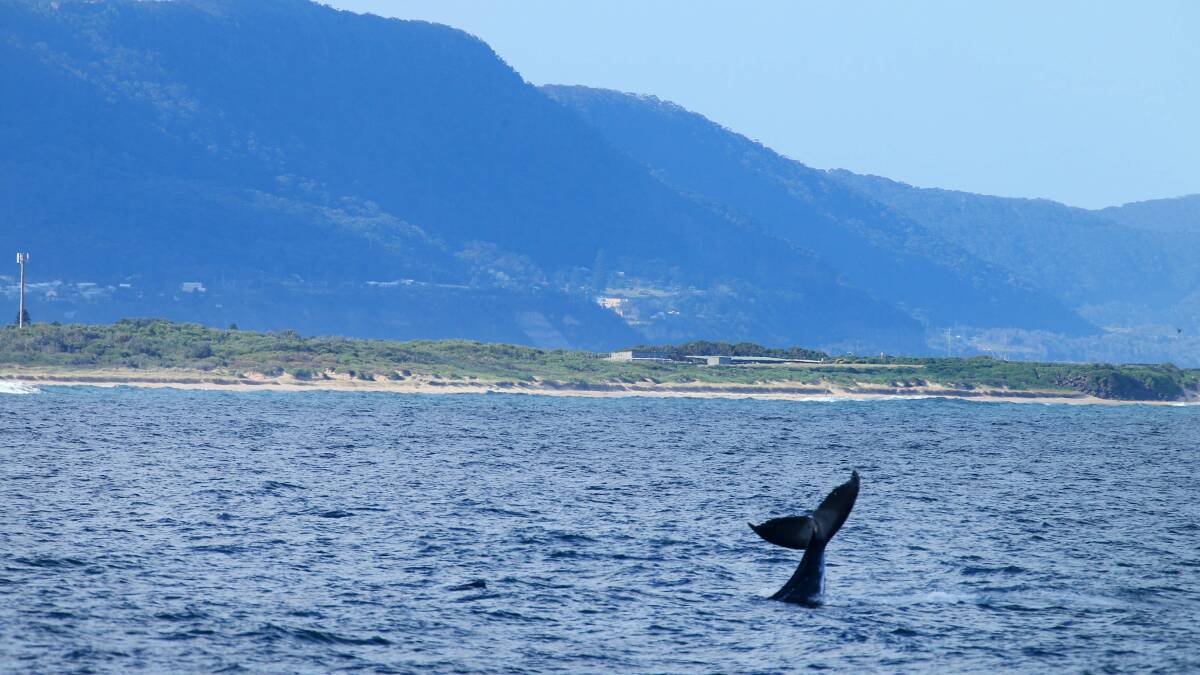Printed on t shirts, emblazoned on signs and frequently cited in speeches, the whales that migrate off the east coast of Australia were a hot topic at the anti-wind farm rally held on Flagstaff Point on Sunday, but whale experts say the "humpback highway" won't be stopped if a proposed offshore wind farm goes ahead.
Subscribe now for unlimited access.
or signup to continue reading
It is estimated that up to 40,000 humpback whales make the journey from the southern Antarctic feeding grounds to the breeding grounds off the north-eastern coast of Australia.
Having dwindled in numbers to as low as 1500 by the mid 20th century due to hunting, humpback whales are now a conservation success story, with the federal government delisting the species as endangered last year.
But, with proposals for offshore wind farms between 10 and 30 kilometres off the coast of the Illawarra, the impact on whales has been frequently cited as a concern.
To find out how whales will be affected, the Mercury spoke to two independent whale experts about the potential impacts resulting from an offshore wind farm.

Dr Vanessa Pirotta is a post-doctoral researcher at Macquarie University in Sydney and the author of numerous peer-reviewed articles on the behaviour of whales in Australian waters.
Dr Pirotta said that most whales travel in a narrow migratory corridor, close to shore.
"That narrow migratory corridor that we refer to as the humpback highway is within 10 or so kilometres of the coastline," she said.
The offshore wind zone as proposed by the Commonwealth is no closer than 10 kilometres off shore in the Illawarra, and the Hunter zone, after consultation, was declared at between 20 and 35 kilometres from the coast.
A 2008 study in Queensland using shore-based observations found 89 per cent of whale groups passed within five kilometres of land and only three per cent were more than 10 kilometres away from the shore.
Dr Pirotta said that whales and other species did travel further out and that the environmental approvals process for the proposed wind farms was an opportunity to understand more about the patterns of behaviour of sea mammals.
In other areas of Australia whales already pass by significant offshore installations. Jeff Weir is a marine biologist and the executive director of the Victoria-based Dolphin Research Institute, and said that there was over half a century of evidence of how whales and other species interacted with offshore energy infrastructure in the Bass Strait.
"Whales have done very well in many places where things have been constructed in the marine environment," he said.
"You look at six decades of oil rigs in the Bass Strait, for example, and the whales swim around them, or sometimes hang around when they're resting, and that doesn't seem to affect them."
Mr Weir said the greatest period when whales could be impacted by wind farms was during the construction phase, when there were additional ship movements and noisy activities. However, these could be scheduled to occur during the two thirds of the year when whales are not present in Illawarra waters.
"The risks during the construction phase could be mitigated by doing the heavy lifting when the whales aren't there, which is two thirds of the year for the majority of the whales."
Once in place, the wind turbines and associated infrastructure would be a target of whales' natural curiosity. Due to this, Dr Pirotta said there were risks of entanglement and that these risks needed to be addressed in the feasibility studies and environmental impact surveys.
"There is no doubt that there's likely to be some sort of interaction over a period of time, and this is something that we need to take into account," she said.
In terms of the ongoing impact from underwater energy installations, Mr Weir again highlighted the experience in the Bass Strait, where the 500 megawatt Basslink interconnector has linked the Victorian and Tasmanian electricity grids for the past 20 years.
"When it was being built we had the same sort of claims, 'All the the sharks are going to go nuts and bump their heads into it and die,'" he said.
"We haven't had a plethora of sharks washing up dead."
In the United States, former president Donald Trump has claimed whale beachings have been caused by offshore wind, however multiple fact checks have found no evidence to connect whale deaths to offshore wind installations.
Both experts stressed that it was reasonable to ask questions of any offshore proposal, but that there were methods of limiting or avoiding impacts built into the approvals process.
"These projects can't just happen overnight," Dr Pirotta said. "There's a series of investigating, project proposals, liaising with different stakeholders, scientists, the general public - so consultation collaboration and working together is really key here."
When looking at the bigger picture, Mr Weir said, there was a balancing act between different impacts, as former Australian Threatened Species Commissioner Gregory Andrews pointed out.
"He said, 'If we're really worried about whales, climate change is the biggest issue facing whales,'" Mr Weir said. "There could be some risks but the risk of not doing something is 1000 times bigger."
Our news app has had a makeover, making it faster and giving you access to even more great content. Download The Illawarra Mercury news app in the Apple Store and Google Play.



